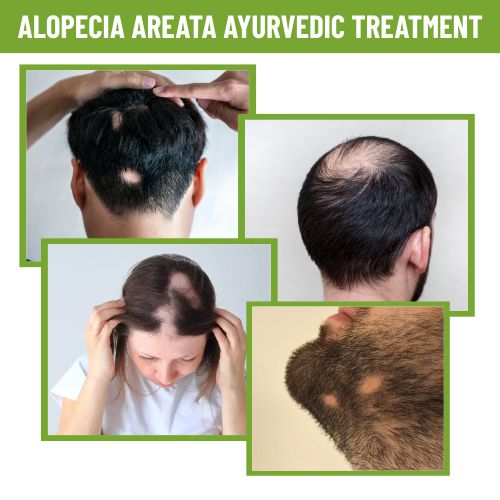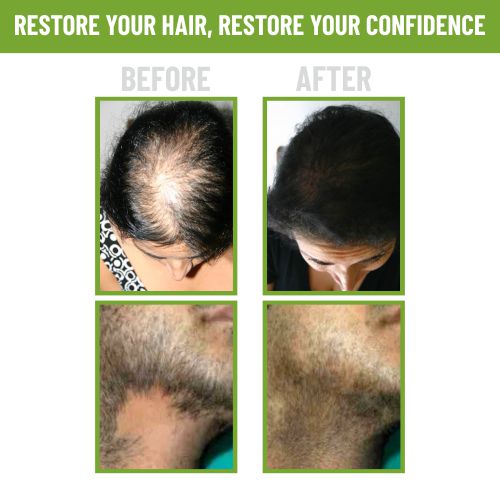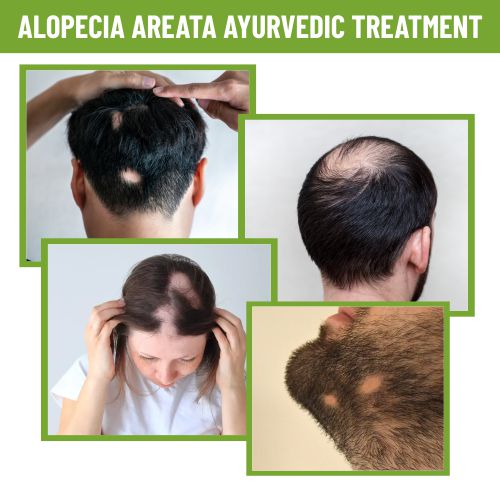Losing 50-100 strands of hair is quite normal but have you noticed round bald patches with extensive hair loss? If yes, then you are suffering from ‘alopecia areata’. ( penu korukudu ) It is a medical condition that damages your hair follicles and causes your hair to come out in clumps. This condition may affect any part of the body, but it is more commonly observed in the scalp, head, and face.
The course and amount of hair loss are unpredictable and may vary from person to person. Some may experience hair loss in small patches around the scalp whereas others may experience extensive hair loss. It isn’t a serious medical condition and recovery from this condition may depend on a variety of factors.
So, if you are suffering from the above-discussed symptoms, you must be fully aware of this hair loss problem. Let’s discuss in detail alopecia areata, its types, symptoms, causes, risk factors, prevention, and treatment methods.
In this article:
- What is alopecia areata?
- Types of alopecia areata
- Symptoms of alopecia areata
- Causes of alopecia areata
- Risk factors of alopecia areata
- Diagnosis of alopecia areata
- Treatment of alopecia areata
- Dietary modifications for alopecia areata
- Self-care for alopecia areata

What is alopecia areata?
Areata refers to an autoimmune condition which is associated with the sudden loss of patches of hair from the scalp and other parts of the body such as the eyebrows, eyelashes, and beard area. With time, the patches become more noticeable, leaving coin-sized bare areas of skin and generalized baldness.
According to the National Alopecia Areata Foundation (NAAF), approximately 147 million people worldwide are affected by alopecia areata with a lifetime risk of 2.1%. It can develop at any age and may occur in both men and women of all races equally. However, most people develop alopecia areata in adolescence and early adulthood, before the age of 30.
This type of hair loss is non-scarring and it doesn’t cause permanent damage to hair follicles. The new hair grows back eventually in most people affected with mild alopecia areata but this process may take time. The recovery is unpredictable and the condition may recur in some cases.
This condition doesn’t cause any physical pain but it can adversely affect the self-esteem and quality of life of an individual. The changes in a person’s appearance can cause psychosocial effects such as anxiety, depression, and other emotional issues. In addition, some patients may also experience other symptoms such as increased eye or nasal irritation after the loss of eyelash or nasal hair.
Types of alopecia areata
There are several types of alopecia areata and each type is characterized by the extent of hair loss, different symptoms, treatment, and prognosis. The main types are:
- Patchy alopecia areata: It is the most common type in which hair loss happens in round coin-sized patches on the scalp and other body parts. This condition may progress to alopecia areata totalis and universalis.

- Alopecia areata totalis: In this condition, an individual loses all the hair on the head and becomes completely bald.
- Alopecia areata universalis: It is an extremely rare condition in which an individual loses all the hair over the entire body and face including eyelashes and eyebrows.
- Diffuse alopecia areata: This condition refers to a sudden thinning of your hair rather than hair loss in patches.
- Ophiasis alopecia areata: In this condition, hair loss occurs in a band shape around the sides and back of the head.
- Alopecia incognita: It is a diffuse type hair loss with short miniaturized regrowing hairs. It does not occur in nails.
- Sisaipho alopecia areata: Excessive hair loss except around the periphery of the scalp.
- Marie Antoinette syndrome (or canities subita): It is a diffuse type hair loss with very sudden graying of hair and loss of pigmented hair.
Symptoms of alopecia areata
People with alopecia areata are usually healthy but always have some type of hair loss which may develop over a few weeks and may persist for years. The common signs and symptoms which are good to recognize alopecia areata include:
- Small, oval, or round patches of hair loss on the beard area of the face, scalp, or other areas of the body with hair
- Smooth bald patches with no redness, rashes, or scarring
- Short broken hairs that are narrow at their base than at their tip
- Hair loss occurs mostly on one side of the scalp
- Sudden hair loss in a very short period
- Hair fall and regrowth in different body areas at the same time
- Itching, tingling, or burning on patches of skin right before the hair fall
- Strip of bald skin on the scalp or widespread hair loss leaving less hair on the head
- Complete or partial loss of eyelashes and eyebrows
- Fingernail or toenail abnormalities including the formation of multiple pits
Causes of alopecia areata
The causes of the alopecia areata are complex and it may develop due to a combination of factors including changes in the immune system and variations in many genes that function in the skin and hair follicles.
In general, the immune system protects the body from foreign invaders such as bacteria and viruses and also recognizes attacks and clears these foreign substances from the body. In some conditions, our immune system misidentifies healthy cells as foreign substances and attacks our body tissues leading to autoimmune disorders.
Alopecia areata is one such autoimmune disorder in which our immune system attacks hair follicles essential for hair growth. As a result hair follicles shrink, leading to inflammation, hair thinning, and damage.
Some of the genes that may participate in the abnormal immune response are the human leukocyte antigen (HLA) complex. This HLA gene complex helps the immune system to differentiate the body’s own protein from foreign substances. This gene complex may undergo some variations leading to an inappropriate immune response targeting hair follicles that leads to alopecia areata.
The above two factors are found to be the major causes of alopecia areata but what causes gene variation and what triggers the immune system to attack healthy hair follicles is not well understood.
Risk factors of alopecia areata
The onset of alopecia areata can be sudden, but some risk factors may influence the development of this autoimmune condition. These risk factors are explained below:
- Severe emotional stress: Stress plays a key role in triggering immune responses in the body, thus can increase the risk of developing alopecia areata.
- Family history or heredity: Alopecia areata is found to be a hereditary disorder which means that parents can pass this disease on to their children. But, there are fewer chances of passing this disease to the future generation as both of the parents must contribute some specific genes to their children to develop it.
- Autoimmune disorders: There occurs a significant association between alopecia areata and other autoimmune disorders such as thyroid disease, vitiligo, rheumatoid arthritis, systemic lupus erythematosus, psoriasis, and inflammatory bowel disease. Individuals with a family history of these autoimmune disorders have a higher risk of developing alopecia areata.
- Young age of onset: Most of the patients develop the first onset of alopecia areata in their 40 with a peak incidence in their 20s and 30s. Individuals developing alopecia areata at a young age have a greater lifetime likelihood of extensive alopecia.
- Race or ethnicity: It is not clearly understood whether race or ethnicity can be a possible contributor to the development of alopecia areata. But, in some studies, it has been found that this condition is more prevalent in Black and Hispanic Americans compared with non-Hispanic white Americans.
Besides the above-discussed risk factors, some other possible risk factors which may influence the development of alopecia areata are oxidative stress, vaccinations, drugs, severe illness, injury, hormonal disturbances, trauma, and low micronutrient levels.
Diagnosis /Prognosis of alopecia areata
Alopecia areata is a medical condition, thus it needs to be properly examined by a dermatologist or trichologist. Your doctor will observe the extent and characteristic pattern of hair loss and examine a few hair strands under a microscope.
Some tests which will be done for diagnosis of alopecia areata are:
- Trichoscopy: It is done by using a skin surface microscope which identifies characteristic features of alopecia areata such as broken hairs, yellow dots, black dots, broken hairs, short vellus hairs, and exclamation point hairs.
- Scalp biopsy: It is done by analyzing a small piece of skin on your scalp to determine if hair loss is caused by other conditions such as fungal infections like tinea capitis.
- Blood test: It is done to rule out the possibility of other autoimmune disorders. If your doctor has found specific antibodies in your blood, he will order some additional tests to determine other conditions, such as thyroid problems or hormonal imbalances.

If you are experiencing any symptoms related to alopecia areata, you must see a certified dermatologist and talk about your disease and its symptoms.
Treatment of alopecia areata
Treatment of alopecia areata depends on the extent, onset, and severity of the condition. Individuals, who have had alopecia areata for less than a year, are recommended to wait as it does not need any treatment and hair may regrow on its own with dietary modifications and self-care. However, treatment becomes necessary in cases that have onset of alopecia areata at a young age, have excessive hair loss, and have noticeable baldness.
The most common treatments used for alopecia areata are listed below:
- Corticosteroids: These are anti-inflammatory drugs used for the treatment of autoimmune disorders. It can be given in the form of a pill, ointment, cream, or injection into the scalp, depending upon the type and age of patients.
Children aged 10 years or younger are prescribed corticosteroid pills whereas individuals older than 10 years of age are injected with corticosteroids in the scalp area. Corticosteroid injections are found to be the most effective treatment for patients with patchy alopecia areata and loss of eyebrows.
- Minoxidil (Rogaine): It is the most common and effective treatment prescribed for pattern baldness. It helps in hair regrowth and stimulates hair growth after applying other treatments. It comes in solution form and is thus easy to apply. It usually takes 12 weeks for optimum results and is effective for eyebrow, scalp, and beard areas.
- Topical immunotherapy: This treatment is used for patients with extensive hair loss, alopecia totalis (complete loss of hair on the scalp), and alopecia universalis (loss of all hair). It works on changing your immune system so that it stops attacking your hair follicles.
It has been used for more than 30 years and shows effective hair regrowth in about 60% to 70% of patients. The limitation of this treatment is that it needs weekly appointments until you completely regrow your hair or the treatment fails to regrow any hair within 6 months.
- Immunosuppressive drugs: Some drugs that may suppress the immune system are used for patients with rapid or severe hair loss. These drugs include oral steroids, methotrexate, and cyclosporine, and can sometimes be used in extensive alopecia areata.
- Non-medical therapies: These include the use of laser and photochemotherapy as safe and effective alternatives to medical treatments. However, these therapies show low response rates, and continued treatment is required to maintain hair regrowth.
- Cosmetic strategies: Some cosmetic approaches such as wearing a wig, and hairpiece might be helpful for women with extensive alopecia. Men can also opt for wigs and shaving their beards and head. Semi-permanent tattooing, makeup, and eyelash extensions can also be helpful for individuals with loss of eyebrows and eyelashes.
- Investigational treatments: New therapies are also emerging for the treatment of alopecia areata. Some of the treatments which are being investigated for efficacy and safety in patients with alopecia areata include Janus kinase inhibitors (tofacitinib and ruxolitinib), platelet-rich plasma, stem cell therapy, and lipid-lowering medications.
Dietary modifications for alopecia areata
There is a well known saying that what you eat impacts your whole body and mind. A nutritious and healthy diet can help to regulate and reverse alopecia areata in some patients as it is not permanent hair loss. Hair follicles are living and thus, hair can regrow with proper nutrition and care.
Scientific evidences have suggested that a deficiency of micronutrients such as vitamins and minerals is associated with development of alopecia areata. Micronutrients can help to reverse alopecia areata by reducing oxidative stress, decreasing inflammation and increasing rapidly dividing hair follicles.
Foods to Include:
Certain foods including micronutrient and antioxidant rich foods can help to control hair loss and stimulate hair follicles for hair regrowth. These foods include:
- Vitamin A rich foods such as pumpkin, carrots, mangos, apricots, broccoli, full-fat yogurt, fish oil, liver, oily fish, eggs, and chicken
- Vitamin B7 or biotin rich foods such as nuts, carrots, tomatoes, bananas, and lettuce
- Vitamin D rich foods such as fortified cereals, fortified rice milk, mushrooms, and oily fish
- Zinc rich foods such as avocadoes, raspberries, beans, and cashews
- Iron rich foods such as dark green leafy vegetables, beans, legumes and pumpkin seeds
Foods to Avoid:

When you are dealing with alopecia areata, you must avoid certain foods which can trigger abnormal immune responses and inflammation. These foods include:
- Animal based protein sources such as red meat
- Dairy products which contain milk protein, casein
- High glycemic index foods, such as sugary foods, refined flour, and bread
- Saturated, polyunsaturated and trans fat such as margarine and corn oil
- Sugars and artificial sweeteners such as diet soda
- Fish abundant in mercury such as mackerel, and swordfish
- Alcohol
Self-care tips for alopecia areata
Alopecia areata is a medical condition; therefore it can’t be prevented and cured completely but some self-care tips can help to cope with this condition. These self-care tips include:
- Learn about the disease, and talk with others who are dealing with it
- Use natural and alternative treatments including acupuncture, aromatherapy, vitamins and supplements (including zinc and biotin), and essential oils for hair regrowth
- Protect bare skin or bald areas from the sun, dust, and cold temperature
- Consider cosmetic approaches to deal with excessive hair loss and baldness
- Observe nail changes and if you experience pain, tell your dermatologist
- Safeguard your eyes, if you have lost eyebrows or eyelashes
- Go for regular checkups to determine the risk of other autoimmune disorders
- Visit a mental health professional if you are suffering from anxiety and depression
- Practice yoga and meditation to cope with the mental stress associated with hair loss
- Connect with friends and family if you are sad and have lower self-esteem due to hair loss
Conclusion
As of now, you must have known that alopecia areata is an autoimmune disorder that causes hair loss by attacking your hair follicles. It is caused due to a combination of genetic and environmental factors, however, the exact cause is still not known.
For proper diagnosis and treatment, it is essential to see a dermatologist who can offer the best possible treatment methods for hair regrowth. Treatment is extensive and dependent on several factors, such as age, severity, and other medical conditions.
If you have noticed sudden hair loss, see a nearby dermatologist and learn about the possible treatments. Do not forget! It is not a permanent hair problem and hair will regrow in some time.
So, follow a healthy nutritious diet, adhere to treatment, and stay stress-free to recover alopecia areata.
Frequently asked questions (FAQs)
1) What is alopecia areata caused by?
Ans. Alopecia areata is usually caused when your immune system attacks your hair follicles. It may cause inflammation, leading to hair loss. However, the exact factors which trigger abnormal immune responses are not understood yet.
2) Is alopecia areata permanent?
Ans. No, alopecia areata is not a permanent condition. The hair may regrow within some time on its own and using other possible treatment methods such as minoxidil and corticosteroids.
3) How do you deal with alopecia areata?
Ans. Alopecia areata causes excess hair loss which may be devastating. It may cause emotional trauma and stress. But one should not forget that it is not a permanent condition and can be treated effectively. So visit a dermatologist and receive appropriate treatment.
4) What makes alopecia areata worse?
Ans. Alopecia areata is often associated with stress, but if stress levels are high it will make the condition worse and you will lose more hair. So try to reduce stress and practice yoga and meditation to cope with stress.


